In his Việt Nam: A History from Earliest Times to the Present, Ben Kiernan argues that in the early history of Vietnam there were two important migrations of peoples into the Red River Delta.
To quote,
“By the time of the classical Chinese contact with northern Việt Nam, the early ethnolinguistic pattern there had been transformed by two external influences from the south and north, from mainland Southeast Asia and southeast China.
“First a new ethnic group migrated into northern Việt Nam from the highlands to the south. These were speakers of Mon-Khmer language scholars call Proto-Vietic, the linguistic ancestor of Vietnamese.
“Arriving in the northern delta, these “Vietic” people joined and eventually supplanted the resident speakers of other Mon-Khmer languages and Tai.
“Meanwhile, from the north, deep in what is now Chinese territory, came the new ethnonym ‘Yue.’” (43)

As demonstrated in the previous post on the Yue migration theory, there isn’t evidence to support this idea that there was a migration into the Red River delta from the north. But let’s put that aside here and look at how Kiernan explains who the possessors of the ethnonym “Yue” were.
Kiernan writes the following:
“Scholars are divided on which linguistic group(s) the Yue belonged to, but at least some of the evidence suggests the Mon-Khmer branch of Austroasiatic.
“Linguists in mainland China and elsewhere have argued that the various peoples known as Bai Yue (‘Many Yue’ or ‘Hundred Yue’) in ancient Southeast China were all or mostly speakers of Tai-Kadai languages, though others including speakers of Austroasiatic languages lived there too.
“Some scholars have even suggested that, like the Proto-Vietnamese, all the Yue peoples were Austroasiatic speakers.”
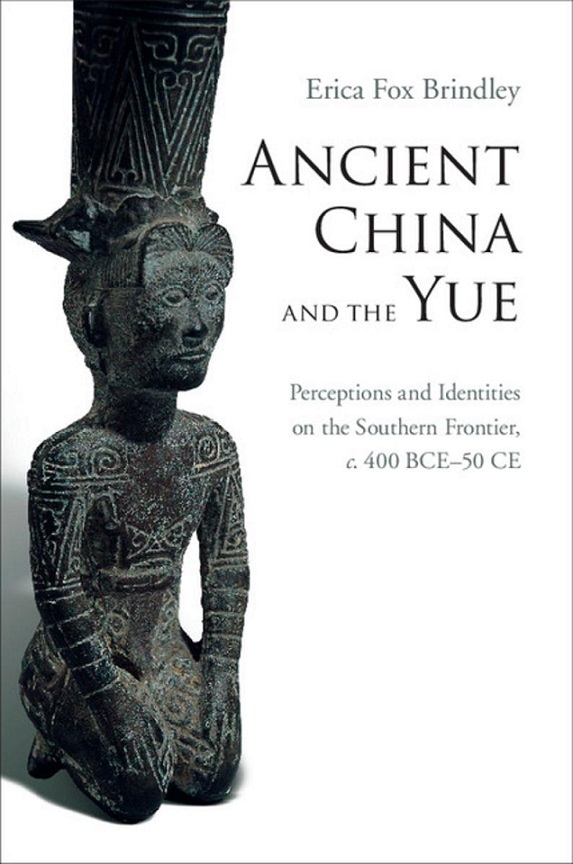
For the final point above, Kiernan cites Keith Taylor’s 1983 The Birth of Vietnam, in which Taylor cited Jerry Norman and Tsu-lin Mei’s 1976 article, “The Austroasiatics in Ancient South China: Some Lexical Evidence.”
For the preceding two points that some of the Yue may have spoken a Mon-Khmer language and that linguists in mainland China have argued that the Yue were mostly Tai-Kadai speakers, Kiernan cites pages 54-59 of Erica Brindley’s Ancient China and the Yue: Perceptions and Identities on the Southern Frontier, c. 400 BCE-50 CE.
On pages 54-55, Brindley discusses some of the linguistic evidence from Jerry Norman and Tsu-lin Mei’s 1976 argument that there were Austroasiatic speakers in the area of what is now southern China in ancient times.
Then on pages 55-56, Brindley discusses the more recent (2008) counter-evidence that Laurent Sagart has presented, and finds “especially convincing” his point that the word for “dog” that Norman and Mei said was Austroasiatic is actually an Austronesian word. (For more on this, see this post.)
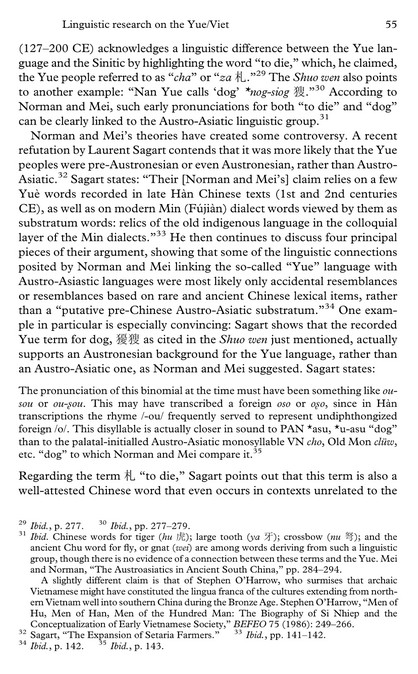
Similarly, on page 56 Brindley does mention that “Many Chinese scholars link the Yue language with an early form of Tai-Kadai.” She provides more information about this and then moves on to discuss a critique of these claims that Sagart has also made.
However, on pages that Kiernan does not cite, pages 46-53, Brindley has a section on “Pre- and proto-Austronesian languages and their relationship to Tai-Kadai” where she discusses a theory that Sagart has proposed that argues that Tai-Kadai is “a daughter branch of proto-Austronesian.” (48)
Brindley provides the evidence for and against this theory and says that the theory is still contested.
Nonetheless, in talking about the evidence that Chinese scholars say demonstrates that Yue peoples spoke a Tai-Kadai language, Brindley states that “if” that evidence is accurate “and if Sagart’s Tai-Kadai hypothesis were correct, then this would mean that the Yue likely spoke a form of PAN [i.e., proto-Austronesian], not AA [i.e., Austroasiatic], as Norman and Mei suggest.”
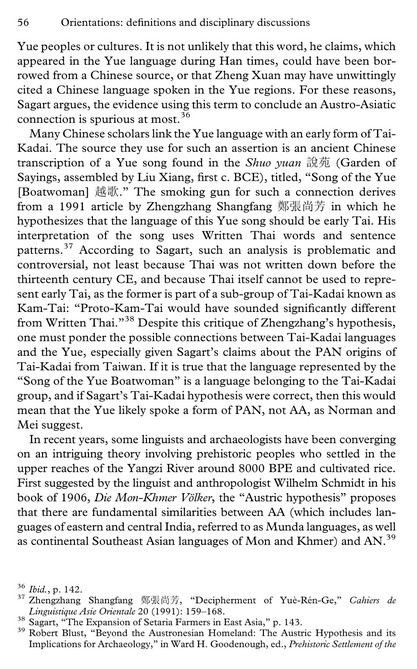
After that passage, Brindley talks about Austronesian, and how there is a hypothesis – the Austric hypothesis – that argues that Autronesian and Austroasiatic languages are related (pgs. 56-58).
On 58 Brindley then discusses Sagart’s STAN (Sino-Tibetan, Austronesian) hypothesis that posits a common origin of those two language families in northern China, and a separate origin for Austroasiatic (presumably in mainland Southeast Asia).
Finally, on page 59 Brindley talks about Hmong-Mien languages.
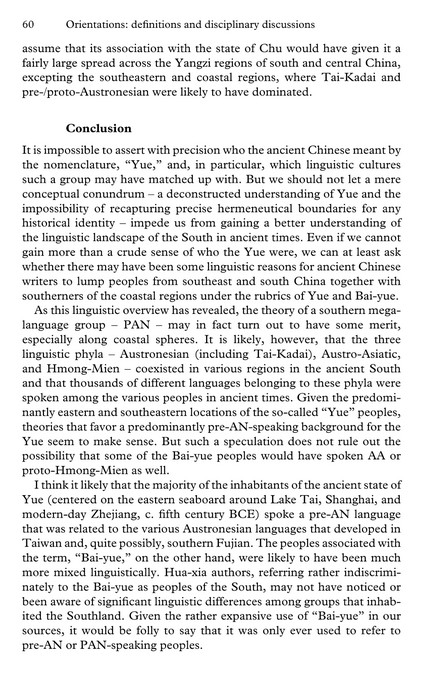
What this shows is that there is a lot more information on those pages than the two points that Kiernan made, that is, that the Yue may have spoken Austroasiatic or Tai-Kadai. In fact, those two theories are, if not outright refuted, certainly presented with serious counter-evidence in these pages.
Meanwhile, Brindley concludes on page 60 that, “I think it is likely that the majority of the inhabitants of the ancient state of Yue (centered on the eastern seaboard around Lake Tai, Shanghai, and modern-day Zhejiang, c. fifth century BCE) spoke a pre-AN [i.e., pre-Austronesian] language that was related to the various Austronesian languages that developed in Taiwan and, quite possibly, southern Fujian.
“The people associated with the term, ‘Bai-yue’ [Hundred Yue], on the other hand, were likely to have been much more mixed linguistically.” And in reference to that point, Brindley states that “Austronesian (including Tai-Kadai), Austro-Asiatic, and Hmong-Mien. . . coexisted in various regions in the ancient South and that thousands of languages belonging to these phyla were spoken among the various peoples in ancient times.” (60)
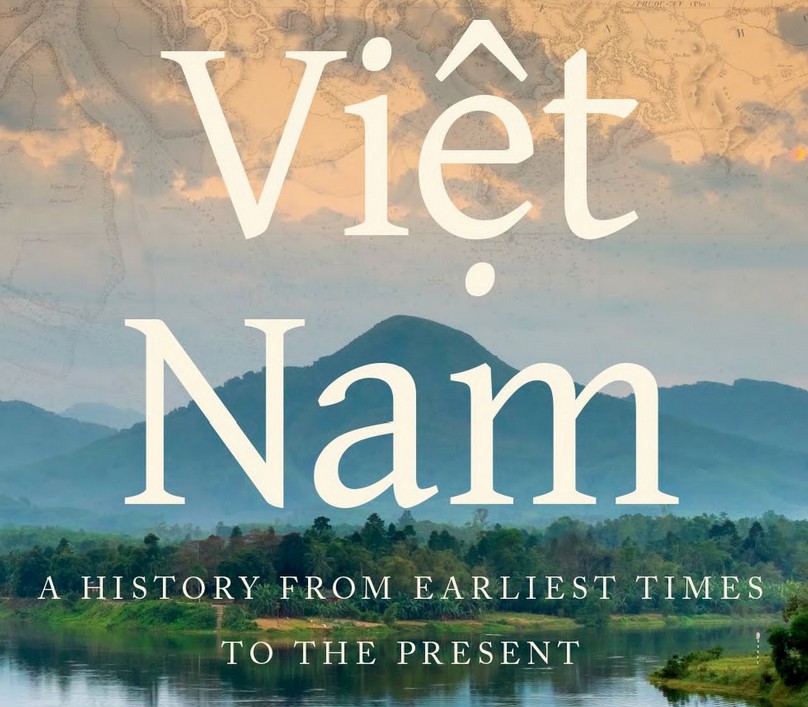
In only talking about Austroasiatic and Tai-Kadai, Kiernan cherry picked information from Brindley’s book. What is more, he cherry picked outdated and clearly problematic information.
While I can’t explain how someone can read those pages and not understand that the two theories that Kiernan chose were probably the most contested (or discredited), this information fit his idea that early Vietnamese history was defined by two migrations: one by Austroasiatic speakers from the south into Tai-dominated areas in the Red River Delta, and one by “Yue” peoples from the north.
Further, as we saw in the post on the Yue migration theory, Kiernan imagines a shared cultural world between people as far apart as the inhabitants of the original Yue kingdom in Zhejiang Province and the Lạc Việt in the Red River Delta, and he imagines a migration of peoples across that shared world. A shared language, or at least a shared language family, would facilitate all of these imaginings.
On the other hand, recognizing that the ancient kingdom of Yue and the area along the southeast coast of mainland China were more likely inhabited by some form of early Austronesian speakers, rather than Austroasiatic speakers, would suggest a potentially more significant cultural divide across the ancient Yue world than Kiernan is willing to accept, as that would undermine his (already unsubstantiated) claim that there were Yue “refugees” who could migrate across the region and easily meld into Lạc Việt society.
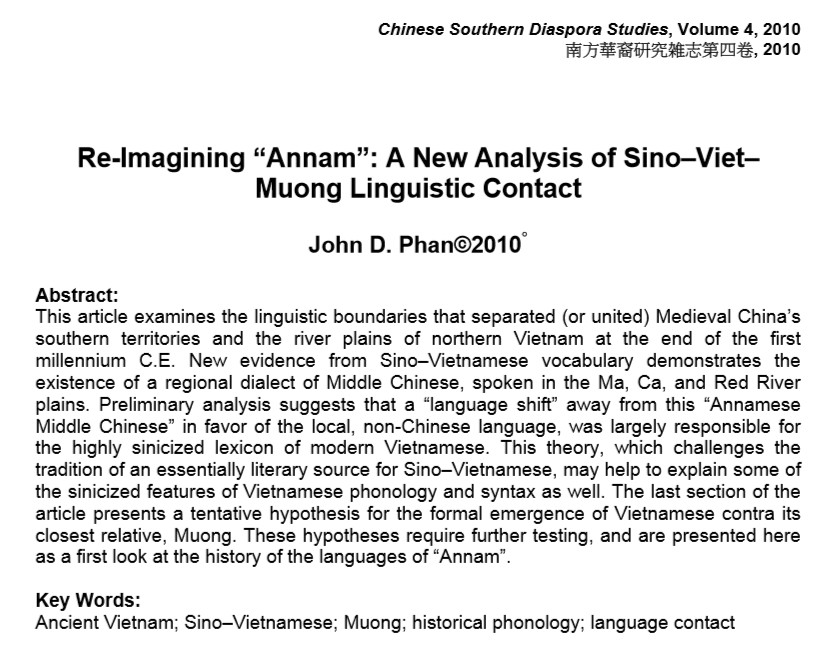
This is by no means the only example in this book of Kiernan cherry picking outdated information. In fact, I see this as a constant theme in this text.
On page 138, in talking about how the Vietnamese language developed in early years of the second millennium AD after a thousand years of Chinese rule, Kiernan says “As Việt-Mường for the first time became the major language at court, it continued to borrow longstanding political vocabulary from Middle Chinese, and also acquired elements of Chinese phonology.”
For this information, Kiernan cites a single page in a 1992 article by La Vaughn H. Hayes (“Vietic and Viet-Muong: a new subgrouping in Mon-Khmer”), and then he says “see also” and cites an entire article from 2010 by John D. Phan (“Re-Imagining ‘Annam’: A New Analysis of Sino-Viet-Muong Linguistic Contact”).
Unless “see also” here is supposed to mean “see also an article which makes a completely different argument from what I just wrote here,” it is obvious that Kiernan has no idea what John Phan proposed in that article.
As such, Kiernan is “up-to-date” on pre-early-1990s scholarship on Vietnam, but not on the work since then.
He “references” later studies, but it’s clear from his text that he either doesn’t understand them or hasn’t read them.

